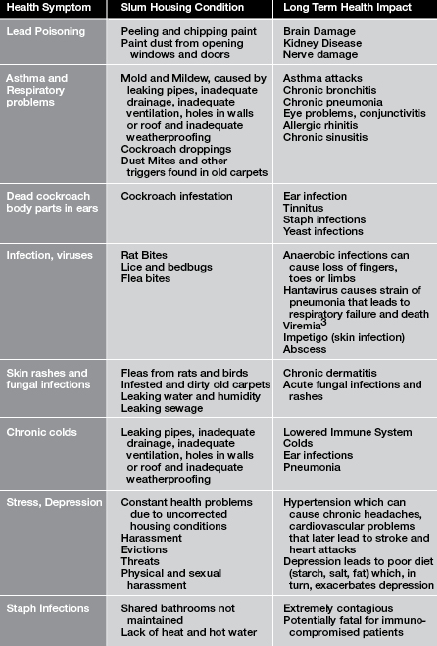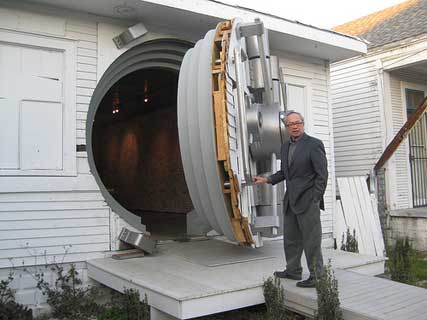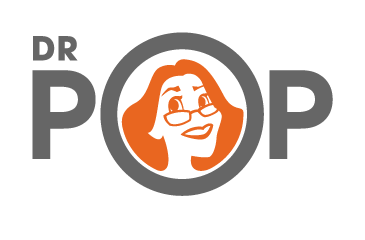poster Seth Tobocman
 While health insurance and bank lobbies vie for the comic-book-villain-of-the-year award, there is nothing more insidious than the invisible health threats that attack us daily without our consent or knowledge — through our water, our food, and our air.
While health insurance and bank lobbies vie for the comic-book-villain-of-the-year award, there is nothing more insidious than the invisible health threats that attack us daily without our consent or knowledge — through our water, our food, and our air.
For parents, the very notion that the homes in which our children play, eat, and sleep might be silently poisoning them, gradually causing nerve and brain damage to developing bodies, is a very hard pill to swallow. Yet for tenants who are trapped by high housing costs in slum housing, this is often the case. The cause is chipping and peeling lead paint, and the uber-villians are the slumlords who profit, often hugely, from dangerous, unhealthy housing conditions.
Although lead paint has been banned from the U.S. since 1978, existing lead paint that chips and peels in neglected homes flake into dust that contaminates the air that children breathe indoors and the soil where they play outside. (intact paint is not a hazard).
In Los Angeles, it is estimated that 48,000 families are living in extreme slum conditions and getting sick as a result, from exposure to lead and other hazards in their homes. In New Orleans, Hurricane Katrina washed chips of lead paint from the homes into the soil, where it remains as a constant threat to children’s health.
The ecological principle that “diversity ensures resilience” applies to the business of solving intractable urban problems. It is not simply a matter of how many eyes and brains are brought to bear on difficult problems, but rather,it is the diversity of those eyes and brains that lead to the best solutions. In the case of childhood lead-poisoning, the solutions are available, but hampered by lack of political will, commitment, alignment, and intelligent resource allocation.
What follows are stories about two efforts, the Healthy Neighborhoods, Same Neighbors Collaborative in Los Angeles and the New Orleans-based Fundred Dollar Bill Project that employ diverse methods and thinking to transforming homes and neighborhoods from sources of poison to healthy sanctuaries for our nation’s children.
Frustrated with the inability of official health and housing institutions and agencies to address the deleterious and escalating health impacts of slum housing conditions in downtown and South Los Angeles, ten years ago, the following organizations joined forces to create a weapon against unhealthy housing conditions that is much more powerful than its parts. I won’t list their individual achievements, which are legion — you can click on the links for that — but will give you a taste of their unique contributions to the mix which has improved the health and housing conditions of thousands of children and families in L.A.
- St. John’s Well Child and Family Center: A network of 10 free clinic sites throughout South Los Angeles that has adopted a human rights frame on health care which is placed front and center in their annual report. Health as a human right is the core principle of their business plan, which St. John’s backs up by dedicating staff to a social medicine program.
- Esperanza Community Housing Corporation: Like other community housing organizations, Esperanza rehabs and builds affordable housing, but within an ecology of jobs, an integrated art and science program, and a health promoters training system that has produced around 300 community-based bilingual health promoters through a program that is considered the gold standard among its peers.
- Los Angeles Community Action Network: Located in the rapidly gentrifying “Skid Row” area, LACAN is a community-building force among the overlapping populations of homeless and residential hotel tenants, who comprise the organization’s leaders and organizing staff. Along-side daily fights against police abuse, evictions, and redevelopment, LACAN hosted the recent L.A. visit by Raquel Rolnik, the UN Special Rapporteur on Housing in the U.S. (click here for the report) ) and coordinated a recent Housing as a Human right action in City Hall, which holds the promise of changing business as usual in L.A.
- Strategic Actions for a Just Economy: I was the founding Director of SAJE, which works on economic justice issues by promoting “urban land reform”, tenant organizing, job preparation and placement, and reforming redevelopment. SAJE’s unique contribution in this mix has been its systematic approach to research on major slumlords, viewing them as criminal syndicates, rather than incompetent landlords. Check out Dr. Pop’s upcoming DIT enews for an article on How to Research Slumlords by our very own Andrea Gibbons, who was also SAJE’s first Research Director.
Together, the Collaborative created an etiology of housing-induced disease that continues to serve as a touchstone for understanding and acting upon the inextricable links between health and housing. As you can see, lead tops the list, but is only one of a myriad of slum housing health hazards.

A good way to track the thinking, actions, and evolution of the collaborative into an effective human rights alliance, is to check out some of their white papers, reports, and events:
- Shame of the City: Slum Housing and the Critical Threat to Children and Families in Los Angeles April 2007
- Taming the Perfect Storm: Addressing the Impact of Public Health, Housing, and Law Enforcement Policies on Homelessness and Health in South Los Angeles A Human Rights Approach. July 2008.
- On June 5, 2009, members of the Collaborative and other allies produced the First Annual South Los Angeles Health and Human Rights Conference, attended by over 700 people which resulted in the South Los Angeles Declaration of Health and Human Rights.
- 2010’s offering is a new report, entitled: Shame of the City: The Sequel which was launched April 20 at a People’s Hearing on Slum Housing, attended by over 350 people.
Mel Chin, an unusual artist by any standards,takes up challenges in art, science, and politics at the same time with relentless curiosity, innovation, persistence, and humor. I had the opportunity to hear him speak about his art and science mashup and the Fundred Dollar Bill Project at Farmlab in February.
The best way to understand the project’s evolution is through the art itself.
In the 90s, Chin began to explore the possibilities of reclaiming contaminated land through “hyper-accumulator” plants — plants that have the capacity leach heavy metals out of soil. He connected with scientist and hyperaccumulater expert Rufus L. Chaney with whom he collaborated with to create the “Revival Fields” project in St. Paul, Minnesotta, which curator Sue Spaid, describes in her book ecovention:
Funded by a $10,000 grant from the National Endowment for the Arts (NEA), Revival Field was the first experiment in the United States to use plants to absorb toxic metals from the soil. This launched the nation’s burgeoning phytoremediation industry, which one business analyst predicts will be a $400 million dollar business by 2005.
 Mel Chin (with Dr. Rufus Chaney), 1990-1993, Pig’s Eye Landfill, Saint Paul, Minnesota
Mel Chin (with Dr. Rufus Chaney), 1990-1993, Pig’s Eye Landfill, Saint Paul, Minnesota
(In case you have trouble connecting to the Art 21 videos about the project, I have embedded them here):
Mel Chin on Revival Fields from Art 21
Revival Fields video with Mel Chin from Gilda Haas on Vimeo.
Cartoon about Hyperaccumulator Plants from Art 21
Cartoon about Hyperaccumulater Plants from Gilda Haas on Vimeo.
After Katrina, Chin created the Safe House which installed a circular bank vault safe door on a home in the 8th ward in New Orleans.

The opening for Safe House launched the astonishingly joyful Fundred Dollar Bill Project which confronts the estimated $300 million it would take to repair the soil in New Orleans with the notion “if we can’t raise $300 million, we can make $300 million” and has engaged school children, such as the ones in the video below from George Jackson Academy, in lending their spirits and creativity to the cause of repairing New Orleans, by drawing their own Fundred Dollar Bills, which are being picked up by an armored car, accompanied by uniformed Fundred guards, all to be delivered to sympathetic Congress people at their final destination in the Capitol. Fundred Dollar bills are on exhibit at the Safe House.
Here are two examples of Fundred Dollar Bills:


Here are what the kids say about the project:
We have so much to learn from kids.

The situation dealing with slumlords is long overdue and it is high time for local authorities and the government to get serious. Please view the link on Utube. This is a typical example of a “Slumlord” Thank you for watching. Please note this is not spam in any shape or form.
Just attempting to help
http://youtu.be/xxp_IS-n2Ew